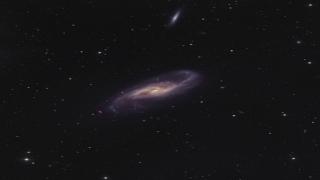Bibcode
Martínez-Lombilla, C.; Trujillo, I.; Knapen, J. H.
Bibliographical reference
Monthly Notices of the Royal Astronomical Society, Volume 483, Issue 1, p.664-691
Advertised on:
2
2019
Citations
43
Refereed citations
36
Description
Disc truncations are the closest feature to an edge that galaxies have,
but the nature of this phenomenon is not yet understood. In this paper
we explore the truncations in two nearby (D ˜15 Mpc) Milky
Way-like galaxies: NGC 4565 and NGC 5907. We cover a wide wavelength
range from the NUV and optical to 3.6 {μ m}. We find that the radius
of the truncation (26 ± 0.5 kpc) is independent of wavelength.
Surprisingly, we identify (at all wavelengths) the truncation at
altitudes as high as 3 kpc above the mid-plane, which implies that the
thin disc in those outer regions has a width of at least this value. We
find the characteristic U-shaped radial colour profile associated with a
star formation threshold at the location of the truncation. Further
supporting such an origin, the stellar mass density at the position of
the truncation is ˜1-2 M⊙ pc-2, in good
agreement with the critical gas density for transforming gas into stars.
Beyond the truncation, the stellar mass in the mid-plane of the disc
drops to just 0.1-0.2 per cent of the total stellar mass of the
galaxies. The detection of the truncation at high altitude in
combination with the U shape of the radial colour profile allows us to
establish, for the first time, an upper limit to the present-day growth
rate of galactic discs. We find that if the discs of these galaxies are
growing inside-out, their growth rate is less than 0.6-1 kpc
Gyr-1.
Related projects

Traces of Galaxy Formation: Stellar populations, Dynamics and Morphology
We are a large, diverse, and very active research group aiming to provide a comprehensive picture for the formation of galaxies in the Universe. Rooted in detailed stellar population analysis, we are constantly exploring and developing new tools and ideas to understand how galaxies came to be what we now observe.
Anna
Ferré Mateu

Spiral Galaxies: Evolution and Consequences
Our small group is well known and respected internationally for our innovative and important work on various aspects of the structure and evolution of nearby spiral galaxies. We primarily use observations at various wavelengths, exploiting synergies that allow us to answer the most pertinent questions relating to what the main properties of
Johan Hendrik
Knapen Koelstra